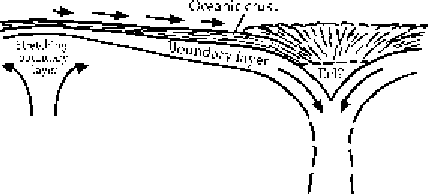Geology Reference
In-Depth Information
Figure 9.17. Sketch of conjectured 'drip tectonics', in which the top thermal
boundary layer of the mantle is not rigid enough to form plates. The structure
of downwellings might then not be controlled by brittle faults, so they would tend
to be more symmetric. Mafic crust would tend to pile up over downwellings, and
if its base became sufficiently deep and warm, it might convert to dense eclog-
ite, triggering foundering of the crust. Such foundering might be highly episodic.
From Davies [154]. Copyright Geological Society of America.
This would overcome one potential obstacle to plate tectonics, that the buoyancy
of oceanic crust would prevent or slow subduction (Section 9.4.2).
There is no consensus at all as to when plate tectonics started operating. At a
conference in 2006, opinions ranged from one billion years ago to 4.5 billion years
ago, with a preponderance in the 2-3.5 Gyr range [163]. There is evidence that the
Earth's surface was cool enough to sustain liquid water 4.4-4.5 Gyr ago [164, 165]
and there is evidence for the presence of some continental crust [165, 166]. This
evidence would be consistent with the operation of plate tectonics, but does not
require it.
There is evidence for ancient compressional zones that resemble modern subduc-
tion zones in many respects, structurally, petrologically and geochemically, though
there are also some significant differences [161, 163]. Such zones are known from
the mid-Archaean through the Proterozoic. However, such zones do not necessar-
ily imply plate tectonics. The distinctive features of modern subduction zones are
that they are structurally asymmetric (only one plate goes down) and that they are
narrow mobile belts between large stable blocks. Both distinctions are important
for inferring the dynamics of the thermal boundary layer and the mantle. The sec-
ond distinction might be of little direct concern to geologists, but it ought to be
of indirect concern, because the style of mantle dynamics implied could be rather
different from the present form, and that would have other important implications,
as the results already presented might suggest.
A symmetric compression zone might indicate something like the 'drip tectonics'
conjectured by Davies [154] and illustrated in Figure 9.17. In this scenario it is
envisaged that the thermal boundary layer is thin enough that it does not act as a
rigid unit over very large distances. Thus there might not be anything we would

